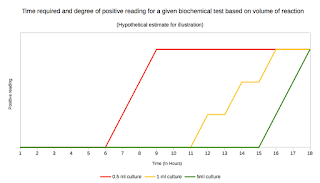MERS COV- Outbreak in Korea
Greetings
With advances in ability to do high throughput DNA sequencing, it has become easier to trace and study infections that has been previously known. This is evident from the recent literature. A lot of new strains have been shown to cause infections sometimes in small pockets of areas, sometimes making big news. I have tried to avoid talking about such pseudo outbreaks with few cases. However it is difficult to say what constitutes an outbreak. The standard definition states, ":A sudden increase in number of cases by a specific strain of pathogen". If you analyze the definition fair enough, that's a very sloppy definition.
| Fig 1: Number of cases of MERS Data from WHO; June 10, 2015 |
The world is talking about, what looks like a possible outbreak of MERS virus infection. I have previously had an in depth discussion of MERS virus (Link). As of today, a total of 108 cases have been confirmed with 9 deaths (Link). The index case was notified on 20 May by WHO. The case was a 68-year-old with a history of travel to 4 countries in the Middle East. The case was non symptomatic during return on May 4. Subsequently, after a week the case developed symptoms and sought medical care at 2 outpatient clinics thereby had sufficient time for potential spread. The contact tracing identified 25 confirmed cases and the numbers have been slowly growing since.
 |
| Fig 2: Age of people- MERS fatality. |
I have received a couple of queries asking how fatal or worried should people be about this infection. So I looked into what I can ind from literature about this current outbreak. I couldn't find anything solid, but had an impression that the virus seems to be fatal only in cases where there is increased risk. Age and co-morbid conditions play an important role. So I gathered the statistics, from around the web and found that all were aged. The minimum age was 57 years, female. I have given the stats in Figure 2. I have tried my best to keep the source as reliable as possible. A case of teenager has surprisingly been recorded to be severely infected, but reports indicate the case is stable.
I was also interested with the distribution of cases, but found Wikipedia already has a updated information. See Figure 3. Looking at the graph, a natural question that was asked is the genetic status of virus. I have seen a couple of internet pages already arguing evolving status. The genetic sequence has already been made available and it hasn't varied enough from past sequences from the Middle East.
South Korea and China are currently under high alert situation and have quarantined several contacts with known confirmed cases. There is scare in public about the virus. With more than 2800 people under quarantine, 108 confirmed cases of which there is 9 fatal the actual fatality rate appears to be quite low. Here's the punch point. In a recently published data, 0·15% of people of healthy people were seropositive for MERS-COV antibodies from Saudi Arabia. This makes me think that probably lot less people are even exposed to this virus. Perhaps those who are in contact with camels. There appears to be a significant risk of virus infection, but a negligible probability of clinical significant serious case. But at this point the data is not enough to make a strong case. Further the dynamics of immune response is not well known for MERS infection and hence interpreting serological studies needs a caution. With publication of a more realistic animal model for studying MERS, some insights are bound to come.
TWiV has devoted a significant amount of time in its show discussing the outbreak (Link). The impact of the outbreak is summed in this wedding photo. Hilariously, surgical mask is not a good protection against virus. It needs to be at least a N90 grade to be really useful.
 |
| Photo 1: MERS scare in S Korea. Source |
Butler, D. (2015). South Korean MERS outbreak is not a global threat Nature DOI: 10.1038/nature.2015.17709
Butler, D. (2015). South Korean MERS outbreak spotlights lack of research Nature, 522 (7555), 139-140 DOI: 10.1038/522139a
Müller MA, Meyer B, Corman VM, Al-Masri M, Turkestani A, Ritz D, Sieberg A, Aldabbagh S, Bosch BJ, Lattwein E, Alhakeem RF, Assiri AM, Albarrak AM, Al-Shangiti AM, Al-Tawfiq JA, Wikramaratna P, Alrabeeah AA, Drosten C, & Memish ZA (2015). Presence of Middle East respiratory syndrome coronavirus antibodies in Saudi Arabia: a nationwide, cross-sectional, serological study. The Lancet. Infectious diseases, 15 (5), 559-64 PMID: 25863564






Comments
Post a Comment